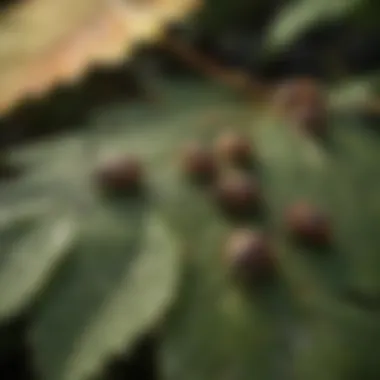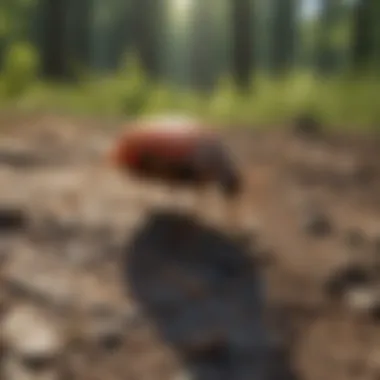Seed Ticks: Their Impact and Management Strategies


Intro
Seed ticks, the larval form of ticks, play a crucial role in the ecosystem, yet they often evoke concern due to their potential impact on human health and wildlife. This article sheds light on their biological characteristics, life cycle, habitats, and behavior. It aims to equip forestry professionals and enthusiasts with the necessary knowledge to understand and manage these tiny creatures effectively. By examining the broader context of forestry practices, sustainable management techniques, and woodland stewardship strategies, we can better appreciate how to mitigate the risks associated with seed ticks while promoting a healthy ecosystem.
Overview of Forestry Practices
Forestry encompasses the science and art of managing forests, which includes the cultivation, conservation, and regeneration of trees. It is not only about timber production but also entails balancing ecological, social, and economic factors. The relevance of forestry in ecosystem management cannot be overstated, as it actively contributes to biodiversity, carbon storage, and water quality.
- Conservation of Biodiversity: Maintaining healthy populations of diverse species within forested areas is essential for ecological resilience.
- Carbon Sequestration: Forests significantly reduce greenhouse gas levels by absorbing carbon dioxide from the atmosphere.
- Water Management: Forests play a vital role in maintaining the hydrological cycle, reducing erosion, and filtering pollutants from water.
Forestry practices directly impact seed tick populations. Healthy forest ecosystems can help control their spread, while poor management practices may exacerbate issues related to tick infestations.
Sustainable Forest Management
Sustainable forest management is essential for ensuring that forest resources meet the needs of current and future generations. This approach incorporates principles that guide the responsible management of forest ecosystems.
- Principles of Sustainable Practices: These include maintaining ecological integrity, promoting economic viability, and enhancing social benefits.
- Techniques in Sustainable Management: Techniques such as selective logging, controlled burns, and habitat restoration are employed to maintain forest health while minimizing adverse impacts on the surrounding ecosystem.
Implementing sustainable practices reduces the likelihood of tick infestations by preserving habitats that support natural predators and minimizing conditions conducive to their proliferation.
Woodland Stewardship Strategies
Woodland stewardship involves proactive management of wooded areas with the aim of ensuring their long-term health and productivity. Understanding the significance of this stewardship is vital for any landowner or forestry professional.
- Importance of Woodland Stewardship: It ensures that ecosystems remain robust and functional, providing habitat for various species, including those that prey on seed ticks.
- Best Practices for Landowners: Landowners can adopt practices such as regular monitoring for pest populations, creating diverse habitats, and engaging in community education on tick management.
"Management strategies rooted in ecology are key to sustaining the balance necessary for both fauna and flora, including the control of seed tick populations."
Effective woodland stewardship is essential in mitigating the impacts of seed ticks, thereby protecting both human and wildlife health. Forest professionals must integrate this understanding into their management strategies to develop a comprehensive approach to tick management and broader ecological health.
Preface to Seed Ticks
Seed ticks, the larval stage of ticks, are often overlooked in discussions about tick-related concerns. It is important to understand their characteristics and roles in ecosystems. This understanding can lead to better management strategies that not only protect human health but also ensure the stability of wildlife populations. Here, we will define seed ticks and explore their significance within their habitats and ecosystems, highlighting why knowledge of these organisms is vital for forestry professionals and those interested in woodland management.
Defining Seed Ticks
Seed ticks are the larval form of ticks that emerge from eggs laid by adult female ticks. They are much smaller than adult ticks, typically less than 1 mm in size. These young ticks have six legs instead of eight, which adults possess. Upon hatching, they require a blood meal to enter the next stage of their life cycle. As such, they tend to be found in environments where they can easily access hosts, including grassy areas and leaf litter.
Importance in the Ecosystem
Seed ticks play a crucial role in the ecosystem. Their presence contributes to the complex dynamics of predator-prey relationships. These ticks serve as a food source for various organisms, including birds and small mammals. Moreover, they can be vectors for diseases, affecting both animals and humans. Understanding the behavior and population dynamics of seed ticks is essential for maintaining ecological balance.
"The larval stage of ticks, while small and seemingly insignificant, has far-reaching implications on both human health and ecological stability."
In addition, seed ticks influence the population dynamics of the animals that they feed on. By studying these interactions, researchers can glean insights into overall ecosystem health and resilience. If seed tick populations are not managed, they can lead to larger infestations impacting wildlife and increasing the risk of disease transmission to humans. This provides a clear rationale for why seed ticks should not be neglected in studies on pest management and ecological integrity.
Biology and Life Cycle of Seed Ticks
Understanding the biology and life cycle of seed ticks is crucial for both ecological insight and public health awareness. Seed ticks, which are the larval stage of ticks, go through distinct life phases that shape their behavior, habitat preferences, and potential to transmit diseases. By comprehensively exploring these elements, one can appreciate not only the biological intricacies of seed ticks but also their place in the larger ecosystem. This knowledge is essential for developing effective management strategies and mitigation efforts against tick infestations.
Life Stages of Ticks
Ticks undergo a complex life cycle involving four stages: egg, larva, nymph, and adult. Seed ticks specifically refer to the larval stage. Each stage has unique characteristics:
- Egg: Female ticks lay hundreds of eggs in protected areas, such as leaf litter. The eggs hatch into larvae in just a few weeks, depending on environmental conditions.
- Larva (Seed Ticks): Once hatched, they seek hosts to feed on. This stage is characterized by their small, six-legged appearance. After a blood meal, they drop off the host to molt.
- Nymph: The next stage features eight legs and a larger body. Nymphs will also seek hosts to feed on before maturing.
- Adult: The final stage, where ticks can reproduce. Adults can live for several years if conditions are favorable.
Each life stage presents environmental challenges and opportunities, influencing population dynamics and interactions with hosts.
Morphological Characteristics
Seed ticks display distinct morphological traits that distinguish them from other life stages. Their small size, often less than 1 millimeter, makes them particularly difficult to spot. Key features include:
- Body Shape: Seed ticks have a flattened, oval-shaped body, facilitating their movement in narrow spaces.
- Coloration: They typically appear light yellow to brown, which provides effective camouflage against their natural surroundings.
- Appendages: Unlike adult ticks, they possess six legs. The legs are slender, aiding in navigation through vegetation.


Recognizing these characteristics is vital for proper identification, which in turn helps in effective management of potential infestations.
Behavioral Patterns
The behavior of seed ticks is closely linked to their survival and feeding habits. Important patterns include:
- Host Seeking: Seed ticks are highly adept at locating hosts. They use a combination of carbon dioxide, heat, and moisture to identify nearby animals.
- Feeding Behavior: After finding a host, they attach firmly and feed on blood for several days. This feeding period is critical for their growth into the nymphal stage.
- Environmental Adaptation: Seed ticks thrive in damp, wooded areas where humidity levels are high, such as forests and overgrown fields. They shelter in leaf litter when not actively seeking hosts.
By understanding these behaviors, forest professionals can implement appropriate strategies to limit tick exposure and enhance public awareness.
Seed Ticks and Human Health
Understanding the relationship between seed ticks and human health is essential, given the potential threats these tiny arachnids pose. Though they are mere larvae, seed ticks can affect humans in significant ways. Their bites can lead to immediate discomfort and long-term health issues, depending on various factors such as the tick species, the duration of attachment, and individual susceptibility. Awareness about this relationship is key for prevention and management, particularly for those working in forestry or spending extended time outdoors.
Known Diseases Transmitted
Seed ticks can be vectors for several diseases which can have serious consequences for human health. Some of the primary diseases associated with ticks include:
- Lyme Disease: Caused by the bacterium Borrelia burgdorferi, Lyme disease is transmitted through the bite of infected ticks. Symptoms may not appear immediately and can lead to severe health issues if untreated.
- Rocky Mountain Spotted Fever: This disease is caused by Rickettsia rickettsii. It is characterized by fever, rash, and can develop into more severe complications if not managed early.
- Ehrlichiosis: A group of diseases caused by bacteria that infect white blood cells. Symptoms often resemble those of the flu and can be life-threatening without treatment.
Other lesser-known diseases, such as Tularemia and Babesiosis, can also be transmitted by seed ticks. Understanding these diseases highlights the importance of immediate action when a tick bite occurs and underscores the necessity for preventive measures.
Symptoms and Identification of Tick Bites
Identifying the symptoms of tick bites is crucial for prompt intervention. When a tick bites, it may not cause immediate pain, but several signs can indicate an infestation:
- Redness or Rash: A red spot or a rash, sometimes resembling a target, may appear around the bite area.
- Swelling and Itching: Accompanying irritation is common, and swelling may develop as a reaction to the bite.
- Flu-like Symptoms: Fever, chills, muscle aches, and fatigue can all manifest within days or weeks, indicating a possible tick-borne illness.
Prompt identification can significantly reduce the risk of disease transmission. If any symptoms arise, especially after a known tick exposure, seeking medical advice is strongly recommended.
"Early detection and treatment are vital in decreasing the risks associated with tick bites and preventing serious health complications."
Ecological Role of Seed Ticks
Seed ticks play a significant role in the ecosystem, influencing various biological and ecological processes. Understanding this role helps in recognizing their importance within different habitats. While often seen as pests, seed ticks contribute to the complex interactions that maintain balanced ecosystems.
Predator and Prey Relationships
Seed ticks serve as a crucial food source for numerous predators. Species such as birds, small mammals, and reptiles rely on these ticks to sustain themselves. This predator-prey dynamic is essential in controlling tick populations and preventing overpopulation. Without these predator species, seed tick numbers could increase unchecked, potentially leading to ecological imbalances.
Additionally, seed ticks themselves are voracious feeders, primarily targeting small mammals and birds. During the larval stage, they attach to their hosts and feed on blood, which is vital for their growth and development. This feeding behavior also influences host populations, affecting things like birth rates and survival rates of smaller animals.
"The intricate relationships between predator and prey highlight the importance of seed ticks in sustaining biodiversity within their respective ecosystems."
Impact on Wildlife Populations
Seed ticks can have profound effects on wildlife populations, both positive and negative. As a food source for many animals, they help support various species in the food web. However, they can also be vectors for diseases, which can impact wildlife health. This dual role requires careful consideration, as the presence of seed ticks may lead to increased disease transmission among wildlife.
Furthermore, fluctuations in tick populations can signal larger ecological changes. For example, an increase in seed tick populations might indicate environmental shifts, such as changes in habitat or climate. Monitoring these trends can provide essential insights into the health of ecosystems.
In summary, seed ticks play a multifaceted role in ecology, acting as both prey and disease vectors while providing essential feedback on the health of wildlife populations. Recognizing their ecological importance helps inform management strategies and fosters a deeper understanding of woodland ecosystems.
Identifying Seed Ticks in the Field
Identifying seed ticks in the field is crucial for managing their populations and preventing potential health risks. Awareness of their presence allows professionals and outdoor enthusiasts to take optimal precautions, thereby minimizing encounters that can lead to tick bites. Understanding how to effectively identify these ticks can inform better management practices and bolster public health safety measures.
Visual Characteristics
Seed ticks, the larval stage of ticks, exhibit distinct visual features that set them apart from other life stages.
- Size: They are relatively small, typically measuring 1 to 2 millimeters in length. Their diminutive size makes them easy to overlook.
- Color: Seed ticks are usually light brown or yellowish, which aids in camouflage within their habitats.
- Body Shape: The body is flattened and oval-shaped, allowing them to navigate through vegetation more easily.
- Surface Texture: Their surface can appear smooth, devoid of intricate patterns, which adds to their subtle appearance.
Being familiar with these characteristics helps in identifying them quickly, allowing for a swifter response if necessary.


Indicators of Infestation
Recognizing indicators of seed tick infestations is key to prevention and control efforts.
- High Tick Activity Areas: Locations such as wooded areas, tall grass, and shrubs often harbor seed ticks during the warmer months.
- Animal Hosts: The presence of small mammals or birds can signify a potential tick population nearby, as these animals are common hosts.
- Geographical Clusters: Finding seed ticks in clusters can indicate a larger infestation. Observing concentrations can help direct management efforts.
Important behavioral cues include increased tick activity during humid weather and a rise in tick bites reported by individuals frequenting specific locales.
Moist conditions provide an ideal environment for seed ticks, enhancing their survival and proliferation.
By honing in on visual characteristics and signs of infestations, stakeholders can engage in more informed practices. Effective monitoring and strategic interventions remain fundamental to managing the ecological impact of seed ticks on both human and wildlife health.
Preventive Measures for Tick Infestations
Preventive measures for tick infestations are crucial in minimizing the risks associated with seed ticks. Seed ticks can pose threats not only to human health but also to wildlife. Implementing effective preventive strategies is essential for protecting both forestry professionals and the ecosystems they manage. The focus here will be on personal protective equipment and environmental management strategies that serve to mitigate these infestations.
Personal Protective Equipment
Personal protective equipment (PPE) plays a significant role in reducing exposure to ticks. Forestry professionals, researchers, and anyone working in tick-infested areas should prioritize appropriate attire and gear. The key aspects to consider include:
- Clothing: Wearing long sleeves, pants, and closed shoes is necessary. Light-colored clothing can help with easier detection of ticks. Additionally, clothing treated with insect repellents like permethrin provides extra protection.
- Repellents: Applying EPA-registered repellents containing DEET or picaridin on exposed skin can deter ticks from attaching. Regular reapplication is advised, especially after sweating or prolonged outdoor activities.
- Footwear: Use boots that cover the ankle and are resistant to moisture. This minimizes risk when walking through grass or wooded areas.
By using proper PPE, individuals can significantly lower their chances of encountering seed ticks during outdoor activities.
Environmental Management Strategies
Environmental management plays a critical role in preventing tick infestations. Addressing the habitat conditions can reduce tick populations and minimize human exposure. Some key strategies include:
- Land Management Practices: Maintaining clear pathways and regularly mowing grassy areas can hinder ticks’ movement and habitat expansion. Also, creating a buffer zone of wood chips or gravel between wooded areas and recreational spaces reduces interactions.
- Reduction of Rodent Population: Measures should be taken to control small mammal populations, particularly rodents, which are primary hosts for ticks. Implementing habitat manipulation, such as eliminating food supplies and nesting areas, can help in reducing these populations.
- Tick Surveillance Programs: Engaging in local tick monitoring initiatives can provide valuable data on tick distribution and enables timely interventions.
Implementing sound environmental management strategies contributes to a holistic approach to reducing seed tick presence.
"Preventive measures are not just about personal safety; they are essential for preserving the ecological balance in our woodlands."
Management Strategies for Seed Ticks
Effective management strategies for seed ticks are essential in minimizing their potential threats to human health and wildlife. Understanding these strategies allows forestry professionals and land managers to address infestations proactively, ensuring both public safety and ecological balance. The importance of these methods cannot be understated, as seed ticks serve as vectors for various diseases. Hence, a well-rounded strategy must encompass chemical controls and natural methods. Each approach has unique advantages, which can be tailored to meet specific environmental and situational needs.
Chemical Controls
Chemical controls refer to using pesticides to manage seed tick populations. Various insecticides can target larval ticks effectively. The strategic application of these chemicals can drastically reduce tick numbers in affected areas. However, consideration is crucial regarding timing and method of application.
Key considerations for chemical controls include:
- Choosing the right chemical: Select the appropriate pesticide that targets the seed tick life stage without harming beneficial insects.
- Application timing: Timing is vital, as larval ticks are most active during specific seasons. This period aligns with their life cycle, enhancing the likelihood of successful eradication.
- Safety protocols: Always adhere to safety guidelines while applying chemicals. This includes wearing protective equipment and ensuring proper treatment methods to avoid contaminating water sources.
Employing these measures can yield significant results. Nonetheless, chemical controls should complement other management strategies rather than serve as a standalone solution.
Natural Predators and Biological Control
Integrating natural predators into management practices offers an ecological alternative to chemical controls. Certain species can effectively reduce seed tick populations. For example, birds, small mammals, and beneficial arthropods play significant roles in controlling tick numbers.
Benefits of using natural predators include:
- Environmental Safety: Unlike synthetic pesticides, biological controls tend to be less disruptive to the ecosystem, supporting long-term sustainability.
- Reduced chemical dependency: Employing natural means lowers reliance on chemicals, which is increasingly important amidst growing concerns about pesticide resistance.
Prominent biological controls involve:
- Encouraging birds and beneficial insects: Create habitats for birds and predatory insects. Plant native flora in these areas to enhance their foraging options.
- Enhancing wildlife diversity: Encourage a healthy ecosystem where predators naturally maintain tick populations.
Community Awareness and Education
Understanding the impact of seed ticks involves not just scientific exploration but also community action and awareness. This section emphasizes the crucial role that education plays in empowering people to manage tick populations effectively. Knowledge about seed ticks leads to informed decision-making, which can mitigate risks associated with tick-borne diseases and ecological imbalances.


Educating both local residents and forestry professionals about ticks helps create a proactive approach to managing these organisms. When communities are well-informed, they can identify signs of tick presence and take appropriate actions to prevent infestations. This collective awareness can decrease the likelihood of disease transmission and enhance biodiversity preservation within local environments.
Raising Awareness in Forestry Practices
Forestry practices are often directly impacted by seed ticks, mainly due to the interaction between tree cover and tick populations. By raising awareness about the presence of seed ticks in forested areas, forestry professionals can take preventive measures during forest management tasks. This is essential for workers who may be exposed to ticks during logging, planting, or maintenance operations.
Key strategies to raise awareness include:
- Training sessions: Regular workshops on tick identification and prevention techniques.
- Informational materials: Distributing pamphlets and guides that outline best practices for avoiding tick exposure in the field.
- Community talks: Engaging local communities in discussions about the ecological role of ticks, thereby increasing their understanding and vigilance.
This awareness not only protects individuals but also contributes to the overall health of the forest ecosystem. When people understand tick behaviors and habitats, they can implement better management practices that balance forestry operations with environmental sustainability.
Collaboration Among Stakeholders
Collaboration is a fundamental element in managing seed ticks effectively. Various stakeholders, such as government agencies, environmental organizations, academic institutions, and community groups, must come together to foster a multi-faceted approach. Each entity brings unique insights and resources that are vital for tackling the complexities of tick management.
Benefits of collaboration include:
- Resource sharing: Access to funding and research from universities can enhance community programs focused on tick awareness.
- Comprehensive strategies: A united front can lead to holistic approaches that consider both ecological and health dimensions related to ticks.
- Informed policies: Collaborative efforts can influence legislation aimed at biodiversity conservation and public health protection.
Working together yields a heightened level of monitoring and response capabilities. For example, collaborative data collection initiatives can provide valuable insights into tick populations and their movement patterns, which is essential for developing targeted management strategies. In this way, a concerted effort can lead to improved outcomes for both ecological health and community safety.
Case Studies
Case studies provide crucial insights into the complexities of managing seed tick populations. They serve as empirical evidence of successful programs and research breakthroughs in tick biology. By examining real-world examples, forestry professionals can draw valuable lessons about effective strategies, challenges faced, and outcomes achieved in various ecological settings.
Outlining the practical implications of these case studies is essential. They demonstrate results obtained through specific management practices, such as the implementation of chemical controls or the use of biological methods. Gainful strategies can include environmental management, community engagement and initiatives to enhance public understanding about tick-related risks.
Various methodologies are often employed in these case studies, ranging from observational studies to experimental approaches. This spectrum of research techniques adds depth to the analysis, allowing professionals to assess their applicability to different environments or regions.
Highlighting successful elements from diverse programs can lead to reproducible results across similar ecosystems. A critical observation gleaned from these analyses can lead to more informed decision-making in tick management practices.
"The adaptation of successful management practices in one community can lead to significant reductions in tick populations in others, necessitating closer collaboration and communication."
Successful Management Programs
Several case studies have showcased successful management programs tailored specifically to seed ticks. For instance, certain forest management practices have been particularly effective in minimizing infestations. In regions where forestry operations are active, maintaining healthy habitats can reduce the likelihood of tick populations establishing. This includes selective logging practices that promote biodiversity, which can also control the growth of potential tick hosts.
Evaluating different types of management programs reveals various strategies that can be applied:
- Integrated Pest Management (IPM): IPM combines biological control, habitat manipulation, and cultural practices. Recent programs have shown promising results with the inclusion of natural predators that target tick populations effectively.
- Community Engagement Initiatives: Programs utilizing community outreach to educate the public about ticks and their habitats have demonstrated success. Increased awareness leads to preventive measures taken by residents, thus reducing overall tick encounters.
- Chemical Application Protocols: Targeted applications have been developed after careful study of their effects on non-target species, ensuring ecosystems remain balanced while controlling tick populations.
Research Developments in Tick Biology
The exploration of tick biology has advanced greatly in recent years, with various research studies shedding light on the unique behaviors and adaptations of seed ticks. Research focuses on significant biological aspects, such as their life cycles, mating patterns, and how they react to environmental changes. This knowledge is vital in developing targeted management strategies.
Some critical developments include:
- Genetic Studies: Examination of tick genomes helps understand resistance mechanisms, making it possible to predict reactions to control measures. These findings can influence the selection of tactics that have the least impact on beneficial species.
- Ecological Interactions: Research highlights the relationships between ticks and other species, especially their hosts. Understanding these interactions can aid in identifying key areas for management interventions.
- Behavioral Studies: Observations of seed tick behaviors have revealed insights into their host-seeking strategies, including how they respond to environmental stimuli. Such developments can refine the timing and method of control measures.
Continuing to invest in tick biology research will contribute significantly to improving management practices and protecting both human and wildlife health.
The End
Understanding the implications of seed ticks is crucial for effective management strategies. This article emphasized the biological traits of seed ticks, their roles within the ecosystem, and their potential health risks. Seed ticks, often unnoticed, play a significant part in the delicate balance of forested environments. Ignoring their impact can lead to consequences not only for human health but also for the wildlife that depends on these ecosystems.
Summary of Key Points
- Seed ticks are the larval stage of ticks, critical to the tick life cycle.
- They transmit various diseases that can affect both humans and animals.
- Identifying infestations early can prevent further spread and health risks.
- Effective management strategies, including chemical and natural controls, are essential.
- Community education and collaboration can enhance awareness and management practices.
This guide provides a holistic overview, aiming to equip forestry professionals and academics with the knowledge needed to address seed tick challenges responsibly.
Future Directions in Seed Tick Research
Research on seed ticks is still evolving. Future studies could focus on:
- Developing more effective management techniques that reduce tick populations without harming the ecosystem. Understanding the behavior and ecology of seed ticks can inform these methods.
- Investigating the relationship between ticks and their hosts, including how climate change is altering these dynamics. Such insight would help in predicting outbreaks.
- Public health studies to explore the long-term effects of tick-borne diseases. This can inform better health policies.
- Innovative technologies such as genetic studies that could lead to breakthroughs in understanding tick biology.
Encouraging interdisciplinary collaboration among researchers, forest managers, and public health officials is essential for a comprehensive approach to managing seed ticks effectively.







